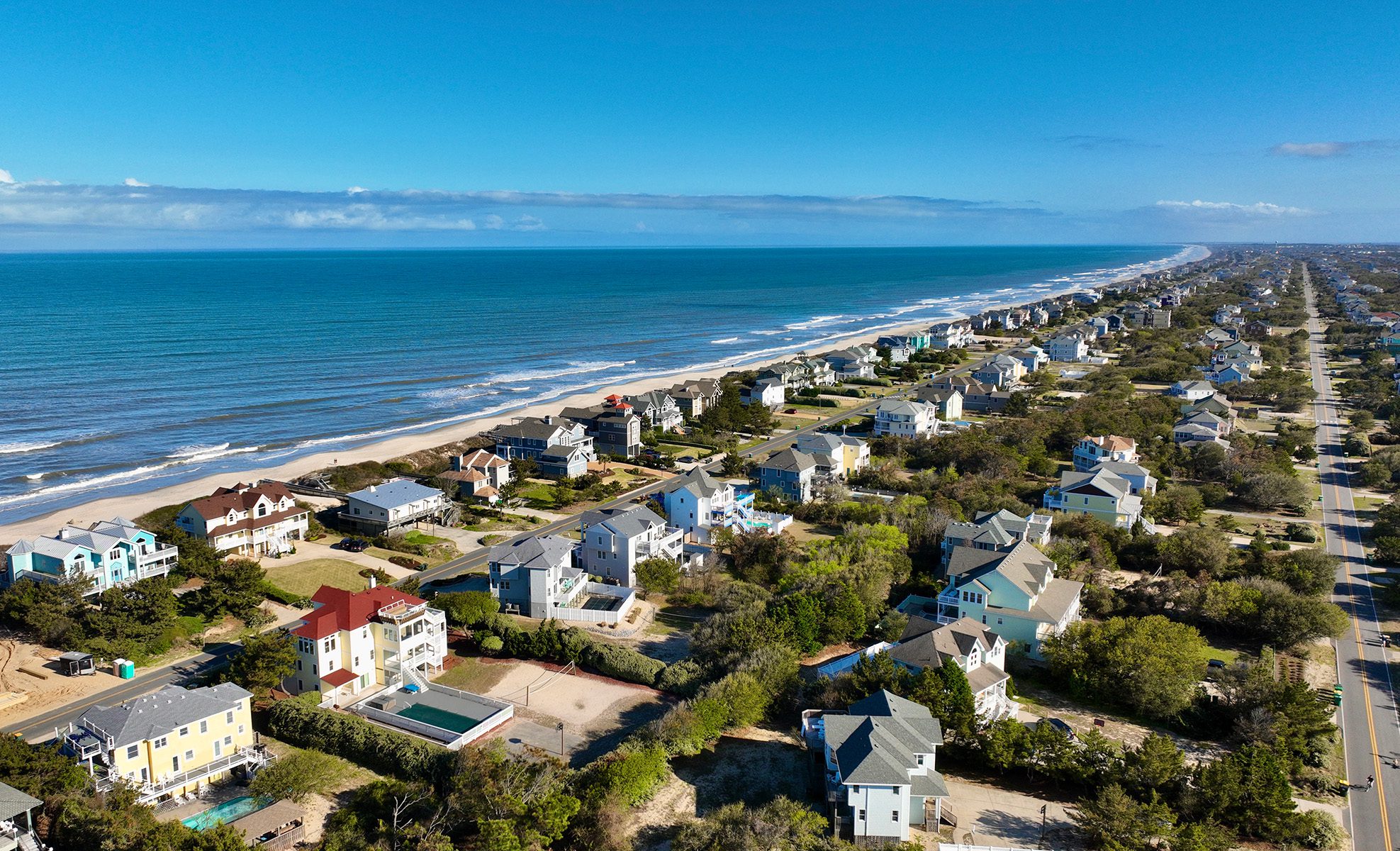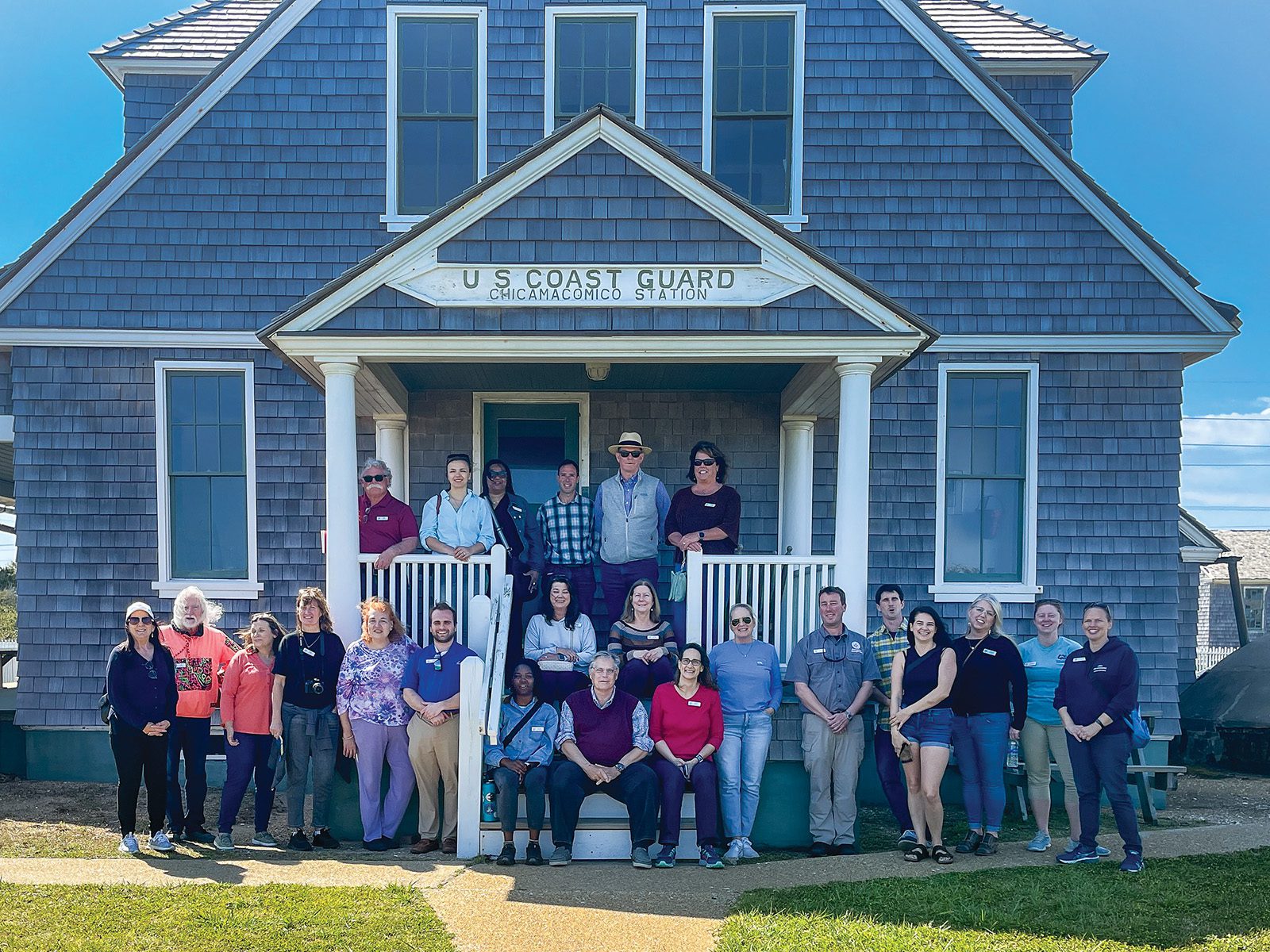The Outer Banks History Center
Professional Archives with Small Town Vibes
By Betsy DiJulio / Photo above: David Stick, Outer Banks Author and North Carolina Historian, looks over old editions of the Dare County Report, 1987. Image courtesy of Drew C. Wilson Photographs Collection, AV.5137, Outer Banks History Center.
Tucked amidst the marshes, wetlands, and maritime forest of the Roanoke Island Festival Park complex, across from the charming Manteo waterfront, sits the newly renovated Outer Banks History Center. From the exterior, though, it maintains its unassuming appearance, blending in unobtrusively with the natural environment by virtue of its rustic Carolina coastal architectural vernacular.
But don’t let that façade and the friendly staff fool you. The highly professional History Center is one of three state archives—the others are in Raleigh and Asheville—administered by the North Carolina State Archives within the North Carolina Department of Cultural Resources’ Division of Historical Resources, Office of Archives and Records Section. And they mean business.
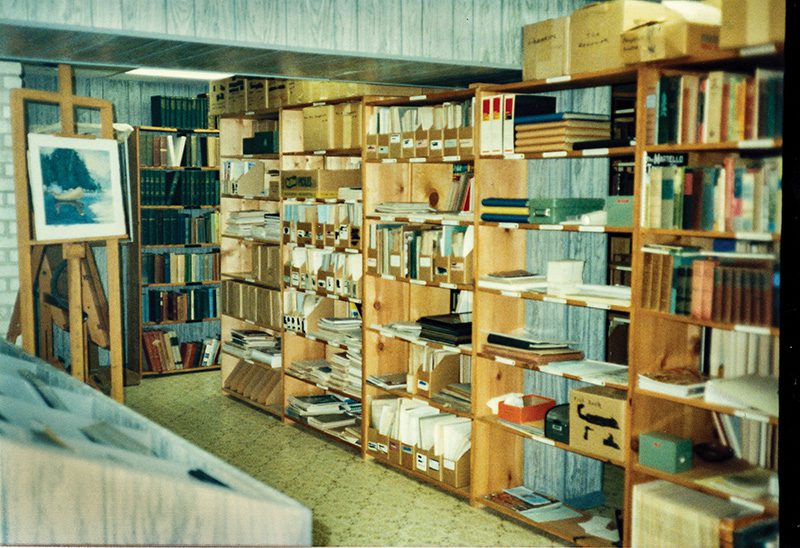
Interior of the David Stick Library at his home in Southern Shores in 1986 prior to its preparation to be transferred to the State Archives in Raleigh to await the construction of the Outer Banks History Center. Image courtesy of Leisa Greathouse, AV.5000, Discrete Audiovisual Items, Outer Banks History Center.
Beyond helpful, the three full-time archivists and one summer intern at the Center enforce policies crafted to preserve the non-governmental coastal history of the state: bags must be stowed in locked compartments, no pens are allowed in the reading room, only one item at a time may be removed from each hand-pulled cart of research materials—and marked with a specially printed card so it can be returned to the correct spot—and it must be laid flat on a library table while perusing.
Despite the rules and regulations, the Center is welcoming and unpretentious. And that professional hospitality starts at the top. In 2023, the Center welcomed its new director, Tammy Woodward. With more than 15 years’ experience domestically and abroad, she is a Certified Archivist with a Master of Library & Information Sciences degree with an archives concentration from the University of Wisconsin-Milwaukee and a graduate certificate in American History from Liberty University.
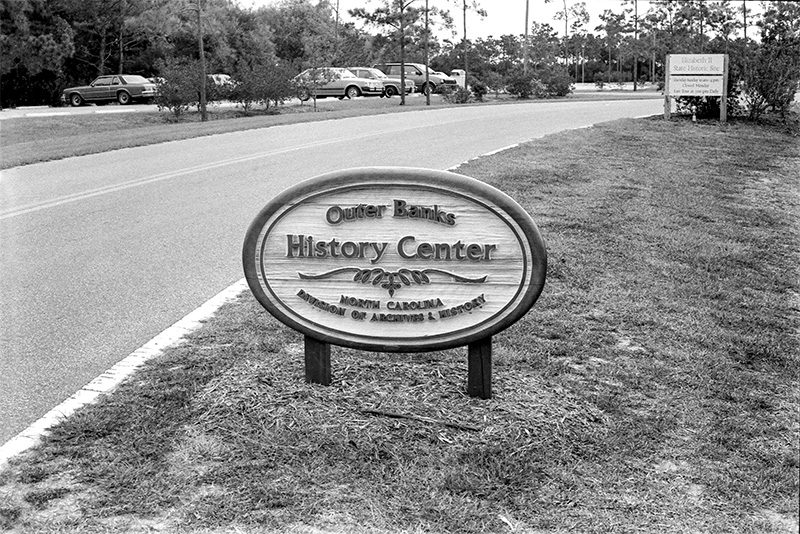
Exterior sign of newly built Outer Banks History Center facility adjacent to the Elizabeth II Historic Site on Ice Plant Island across from downtown Manteo (Roanoke Island Festival Park was later built connected to the OBHC in 1998 to replace the Elizabeth II site). Image courtesy of Outer Banks History Center staff photos.
When asked why she loves her job, she responds, “because I get to save history every day.” She continues, “A few years ago, I attended a Society of American Archivists conference, and one of the vendor booths offered a prize giveaway if you would put on a cape and hold up a sign that read, ‘My Superpower is Saving History!’ so that the vendor could post it on social media. That phrase stuck with me…”
Though the concept of an archive might sound dusty and forgotten, that is not the case here. Not only does the Center preserve history but it makes it accessible. That historical record, says Woodward, “might be someone’s family photographs, an oral history interview with a person whose story is now long forgotten, a map of a community that no longer exists, a longstanding business’s ledgers and daybooks, or blueprints of important structures like a lighthouse or a bridge. These are all important records of our history that must be safeguarded so that future generations can access them. The sky is the limit on the types of historical materials that find their way into the archives.”
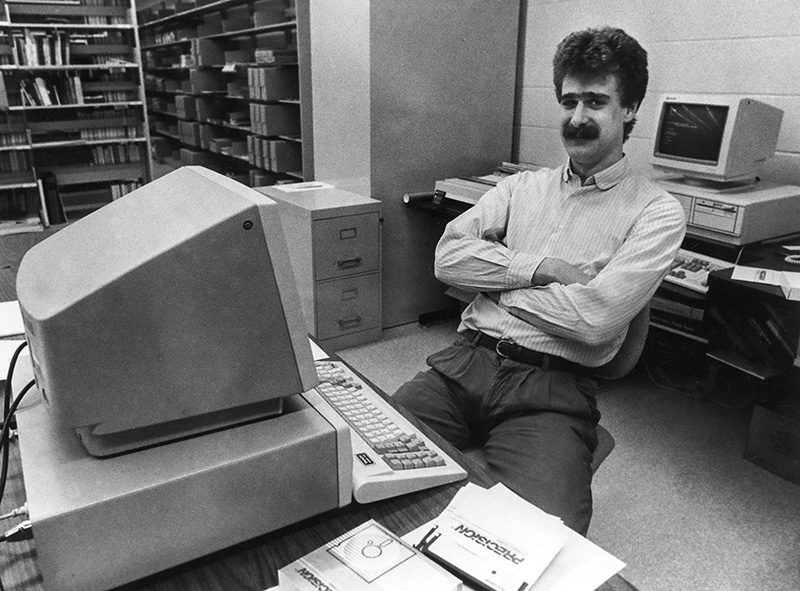
David Minor, computer specialist and assistant curator, one of the first employees of the Outer Banks History Center, 1989. Image courtesy of Drew C. Wilson Photographs Collection, AV.5137, Outer Banks History Center.
She explains that, as the eastern branch of the State Archives of North Carolina, the Center is a state government repository, but their collections come from the community through donations from individuals, families, businesses, and organizations. “The History Center is entrusted with preserving the history of Eastern North Carolina by the local community so that community members know that their history is safe, preserved, and available when they need it. But the local community isn’t the only winner when it comes to archives. Under the watchful eye of our professional archivists, historians, authors, students, genealogists, and other researchers come from all over the country (and outside the country) to use these materials for their research.”
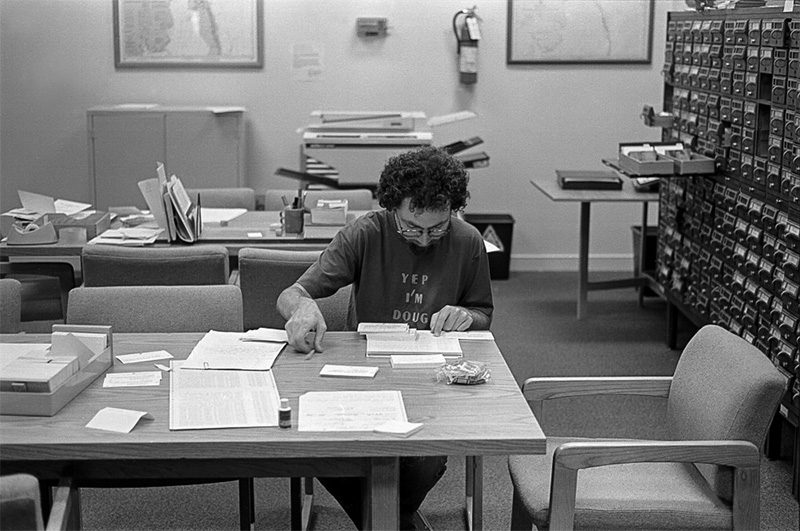
Doug Dino, researcher, viewing archival materials in the OBHC’s first Research Room, a space now used as offices, ca. 1991. David Stick’s card catalog for his library in the background. Image courtesy of Outer Banks History Center staff photos.
Woodward finds beauty in the fact that every archive is different. “Some are found in universities or libraries, in museums or historical societies, while others preserve the records of our governments – local, state, and federal. The important thing to remember is that archivists don’t preserve and catalog these wonderful materials for themselves – they do it for you! The public! There is nothing more satisfying to an archivist than accepting a new collection for donation, cataloging and preserving its fragile materials to ready them for public use, and then watching a researcher make a new discovery using that collection. We love those Aha! moments in the reading room.”
The Center was closed from November 1, 2024, through August 11, 2025, for upgrades. As a result, the reading room offers 1,255 square feet of recently refreshed space for patron research. Its companion, the Stack Room, boasts 3,335 square feet of climate-controlled archives space and a new state-of-the-art fire suppression system for what is referred to as the “special collections” held here. Throughout the interior—which also includes a small lobby and gallery with rotating exhibitions, offices, a kitchen, and a restroom—is all new carpeting, paint, ceilings, LED lighting, spray foam insulation beneath the floor, and replaced ceiling insulation.
This non-circulating archive with its online catalog of holdings will accept virtually anything—except government records and artifacts—with research value and a signed Deed of Gift. “The where, when, who is critical,” says Woodward. This includes personal papers, business records, photos, film, recordings, organizational records for clubs and associations, church records, maps, periodicals, manuscripts, and non-fiction books such as North Carolina history and cookbooks. Subjects run the gamut from the coastal environment to genealogy, maritime history, 20th century development activity on the Outer Banks, natural history, and commercial fishing. For a cost-recovery fee, the Center staff can make scans or prints of anything for which they own the copyright. Popular items include maps and famous photos—like Andy Griffith leaning against the Pioneer Theater—for beach house and restaurant décor.
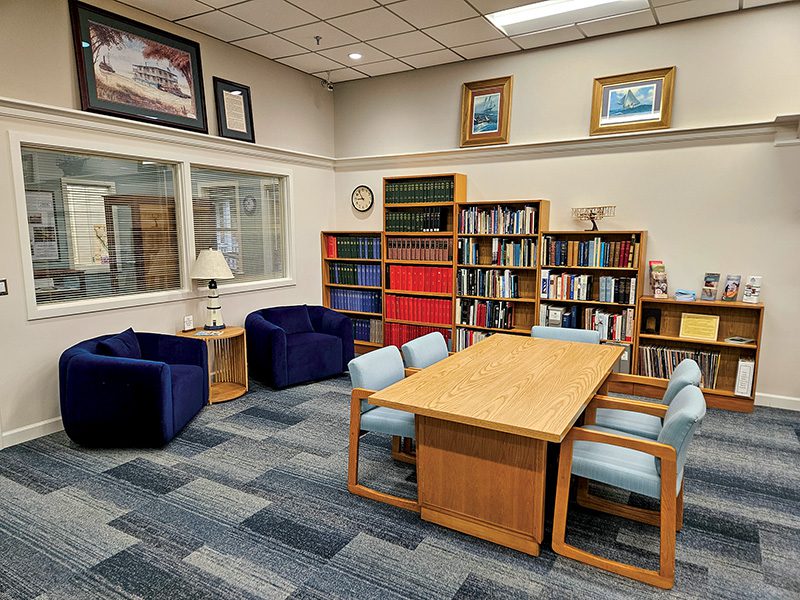
Photographs of newly renovated Research Room at the Outer Banks History Center, August 2025. Images courtesy of Tammy Woodward, Director, Outer Banks History Center.
Annually, the Center responds to thousands of research requests from writers, historians, scholars, journalists, genealogists, and the general public globally. In fact, it was the donation of one such writer and historian’s personal library that gave rise to the Center. As such, it could be said that the Center is, in many ways, as much about the history of David Stick as it is the history of coastal North Carolina.
While this local politician, businessman, and community activist was conducting research for his book Graveyard of the Atlantic: Shipwrecks of the North Carolina Coast (UNC Press, 1952), he amassed an extensive collection of materials. It eventually grew to fill virtually every room of his Southern Shores home based on Stick’s view that it would be more cost-effective and efficient to create his own library than to travel to others.
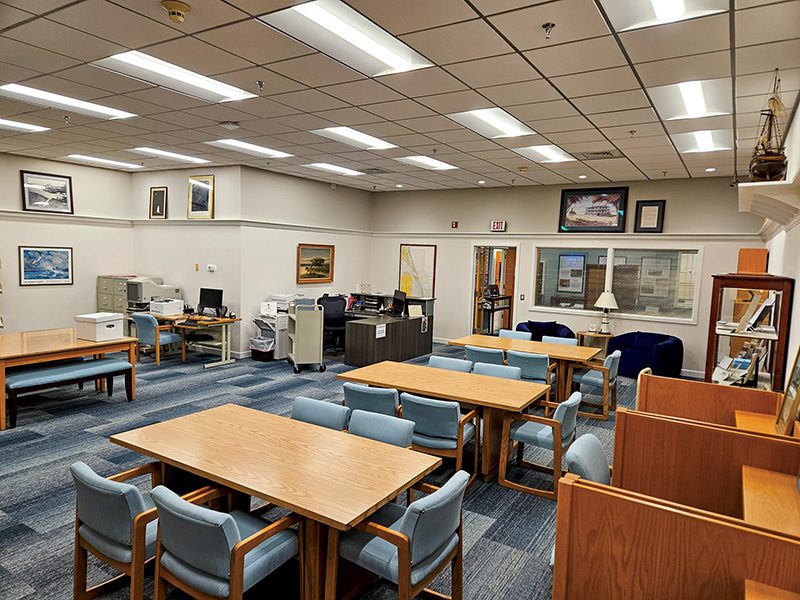
Photographs of newly renovated Research Room at the Outer Banks History Center, August 2025. Images courtesy of Tammy Woodward, Director, Outer Banks History Center.
Though plans and assessments began in 1978, in July 1986 Stick officially donated his library to the North Carolina Division of Archives and History making his gift the catalyst for the Outer Banks History Center. The other core collection of the archives is over 300 paintings by Stick’s father, Frank. Thanks to then senator Marc Basnight, an initial state appropriation of $750,000 that year allowed for the construction of the Center, completed in 1988 and dedicated in 1989. Since then, the Center has added over 400 collections to its holdings and the robust acquisitions are ongoing.
Though our world is defined by change, this collection is guaranteed to remain in Manteo in suitable housing and available for public use in perpetuity.
Community members who are passionate about local history are invited to join the Friends of the Outer Banks History Center (formerly the Associates). This support organization conducts membership drives and outreach initiatives, as well as providing volunteer labor for outdoor events.
Outer Banks History Center
Roanoke Island Festival Park, 1 Festival Park, Manteo
252-423-5240 | www.archives.ncdcr.gov/researchers/outer-banks-history-center




